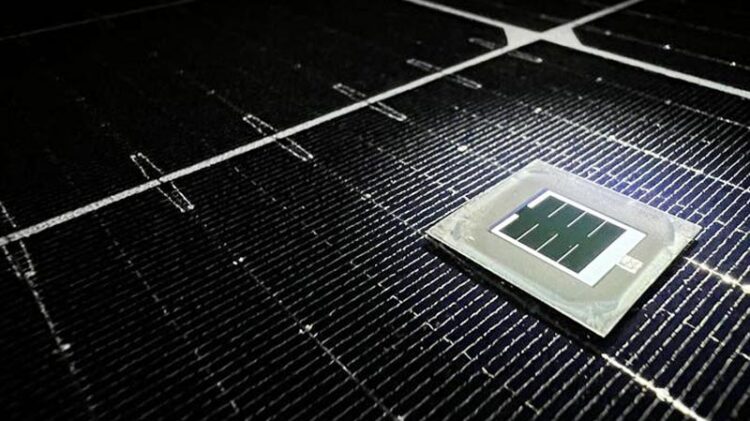Blueprint for affordable solar cells to power Saudi Arabia

A perovskite/silicon tandem solar cell.
Credit: © 2024 KAUST
Thuwal, Saudi Arabia, Month Day, Year – Scientists at King Abdullah University of Science and Technology (KAUST) have unveiled a roadmap for bringing perovskite/silicon tandem solar cells to market, paving the way for a future powered by abundant, inexpensive clean energy in Saudi Arabia and the world.
The authors of the article, published in esteemed journal Science, include Prof. Stefaan De Wolf and his research team at the KAUST Solar Center.
The team is working on improving solar efficiency to meet Saudi Arabia’ solar targets.
Perovskite/silicon tandem technology combines the strengths of two materials – perovskite’s efficient light absorption and silicon’s long-term stability – to achieve record-breaking efficiency. In 2023, the De Wolf laboratory reported two world records for power conversion efficiency, with five achieved globally in the same year, showing rapid progress in perovskite/silicon tandem technology.
However, translating laboratory success to real-world application requires careful consideration. The paper outlines key challenges and proposes solutions for commercialization.
Among these is the consideration of real-world conditions, like variable temperature and sunlight. The authors suggest geographical testing – akin to personalized medicine for solar cells – to optimize performance for specific locations.
Another consideration is accelerated stability testing. The deployed solar cells must have a lifespan that lasts decades. Accordingly, tests that compress years of wear and tear into a much shorter timeframe are necessary. Understanding degradation rates is crucial for setting competitive prices and warranties.
Finally, current manufacturing processes involve high material costs and potentially dangerous chemicals that may require costly safety precautions. The paper proposes paradigms for both monolithic and mechanically stacked tandem production lines to identify cost-reduction opportunities.
“The market for perovskite/silicon tandems is expected to exceed $10 billion within a decade,” said Professor Stefaan De Wolf. “KAUST is at the forefront of this revolution, laying the groundwork for affordable, accessible clean energy for all.”
Erkan Aydin, another author of the study is expected to leave the De Wolf lab in 2024 to start his own in Europe.
The breakthrough research at KAUST on perovskite/silicon tandem photovoltaics exemplifies the University’s commitment to developing green technologies that advance carbon-free policies and secure a sustainable future.
About King Abdullah University of Science and Technology (KAUST)
Established in 2009, King Abdullah University of Science and Technology (KAUST) is a graduate research university devoted to finding solutions for some of the most pressing scientific and technological challenges in the world as well as Saudi Arabia in the areas of food and health, water, energy, environment and the digital domain. KAUST is a curiosity-driven, interdisciplinary
KAUST brings together the best minds from around the world to advance research. More than 120 different nationalities live, work and study on campus. KAUST is also a catalyst for innovation, economic development and social prosperity, with research resulting in novel patents and products, enterprising startups, regional and global initiatives, and collaboration with other academic institutions, industries and Saudi agencies.
Journal: Science
DOI: 10.1126/science.adh3849
Article Title: Pathways toward commercial perovskite/silicon tandem photovoltaics
Article Publication Date: 12-Jan-2024
All latest news from the category: Power and Electrical Engineering
This topic covers issues related to energy generation, conversion, transportation and consumption and how the industry is addressing the challenge of energy efficiency in general.
innovations-report provides in-depth and informative reports and articles on subjects ranging from wind energy, fuel cell technology, solar energy, geothermal energy, petroleum, gas, nuclear engineering, alternative energy and energy efficiency to fusion, hydrogen and superconductor technologies.
Newest articles

Innovative 3D printed scaffolds offer new hope for bone healing
Researchers at the Institute for Bioengineering of Catalonia have developed novel 3D printed PLA-CaP scaffolds that promote blood vessel formation, ensuring better healing and regeneration of bone tissue. Bone is…

The surprising role of gut infection in Alzheimer’s disease
ASU- and Banner Alzheimer’s Institute-led study implicates link between a common virus and the disease, which travels from the gut to the brain and may be a target for antiviral…

Molecular gardening: New enzymes discovered for protein modification pruning
How deubiquitinases USP53 and USP54 cleave long polyubiquitin chains and how the former is linked to liver disease in children. Deubiquitinases (DUBs) are enzymes used by cells to trim protein…



